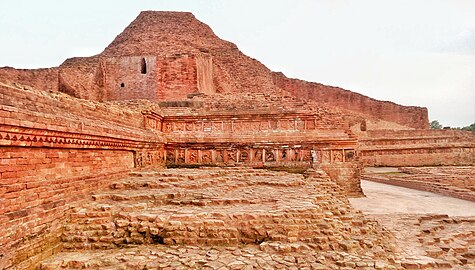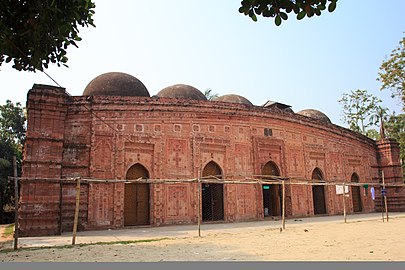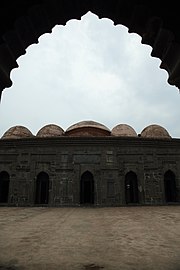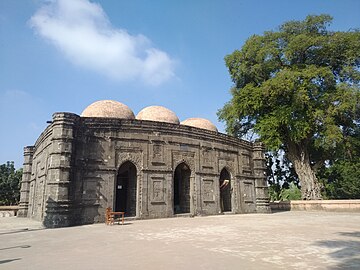|
Vikidia currently has 4,625 articles. Improve it! |
|
Join Vikidia: create your account now and improve it! |
Bangladesh
| People's Republic of Bangladesh | |||
|
| |||
| Official languages Capital |
Bengali Dhaka | ||
| Area Government |
148,460 km2 (57,320 sq mi) Unitary parliamentary republic | ||
| Population Religion |
170,000,000 Islam | ||
| Time zone Currency |
BST (UTC+6) Taka | ||
| Demonym |
Bangladeshi | ||
| Monarch |
Current Previous |
Sheikh Hasina Khaleda Zia | |
Bangladesh (/ˌbæŋɡləˈdɛʃ, ˌbɑːŋ-/; Bengali: বাংলাদেশ, pronounced [ˈbaŋlaˌdeʃ] ), is located in South Asia, and its official name is the People's Republic of Bangladesh. It shares borders with India's West Bengal to the west, Assam, Tripura, and Mizoram to the east, and Myanmar's Chin and Rakhine states to the southeast. The Bay of Bengal lies on the south coast of Bangladesh. The country is situated across a significant part of the world's largest delta and is home to more than 170 million people, making it the 8th most populous country globally. Fifty-seven international rivers traverse Bangladesh. Bangladesh's northeastern and southeastern regions are covered with mountains dating back to the Tertiary period. The country is home to the world's largest mangrove forest, the Sundarbans, and Cox's Bazar Beach, the longest natural beach.
During South Asia's ancient and classical period, several townships were formed in the Bangladesh region, including Banga, Pundra, Gaur, Gangariddhi, Samatat, and Harikel. This region was a province of the Maurya Empire during the Maurya period. These townships were famous for their naval power and maritime trade. They exported muslin and silk to the Middle East and the Roman Empire. In the first millennium, the Pala Empire, the Chandra Dynasty, and the Sen Dynasty were established in Bangladesh. Islam spread to the region after the conquest of Gaur by Bakhtiar Khalji and during the Delhi Sultanate. Europeans considered Shahi Bengal to be the wealthiest commercial country in the world.
During the Mughal period, 12 percent of the world's gross domestic product (GDP) was generated in Subah Bengal, more than Western Europe's GDP. From 1765 to 1947, the territory of Bangladesh was part of the Presidency of Bengal. After the partition of India in 1947, the Bangladesh region became part of the newly formed Pakistani dominions called East Bengal (1947–1956; East Pakistan, 1956–1971). From 1947 to 1956, when Bengali nationalism developed centered on the Bengali language movement, East Pakistan was established as an independent and sovereign nation-state called Bangladesh in 1971 through the democratic and armed struggle with the help of India against the various political, cultural, and economic exploitation, discrimination and oppression of West Pakistan. During the post-independence period, famine and natural disasters occurred in poverty-stricken Bangladesh multiple times. In addition, prolonged political instability and repeated military coups have disrupted the country's overall political stability. The anti-dictatorship movement of the 1990s led to the re-establishment of parliamentary rule in 1991, which continues to this day. Despite all the adversities, Bangladesh's economic progress and prosperity in the last three decades have been recognized worldwide.
Bangladesh is the eighth largest country in the world by population, although it is the 92nd by area. Bangladesh is the most densely populated country in the world, after six small islands and city-states. This tiny country of less than 56,000 square miles has an estimated (2018) population of over 18 million, i.e., 2,889 people per square mile (1,140 people per square kilometer). Bengali is the mother tongue of about 99% of the country's population; the Literacy rate is about 75.2%.
Bangladesh's gross domestic product (GDP) at current market prices in FY 2017–18 was Tk 22,50,479 crore (US$ 261.27 billion), estimated to increase to US$ 285.82 billion in FY 2018–19. In 2017-18, the average annual income per capita of the people of Bangladesh was 1752 dollars. The government has estimated that the per capita income in the fiscal year 2018-19 will be $1,956 or Tk 1,60,392. The poverty rate is 20.5 percent, the number of inferior people is 10.5 percent, and the annual poverty reduction rate is 1.5 percent. This developing country has achieved economic growth of 5 to 6.2 percent per annum for nearly two decades and has ranked among the top 11 economies. The expansion of the capital, Dhaka, and other cities is acting as the driving force behind this development in Bangladesh. Central to this has been the rapid development of an ambitious middle class and the emergence of a capable and active entrepreneurial class. Bangladesh's export-oriented garment industry is particularly well-known throughout the world. Workforce export is also one of the country's economic pillars. The World Bank estimates that Bangladesh's economy will grow at an average rate of 6.7 percent per year during the two fiscal years 2018-20.
Situated in the fertile basin of the Ganges-Brahmaputra, the country experiences seasonal floods almost every year, And cyclones are also very common. Pervasive poverty, the main problem of this low-income country, has been controlled mainly in the last two decades. Literacy rates have increased rapidly, and birth control programs have achieved unprecedented success. Besides, Bangladesh has achieved exemplary progress in the international human resource development index. However, Bangladesh still faces some significant challenges, including pervasive patriarchy, political and administrative corruption, economic competition in the context of globalization, and the threat of subsidence as a result of sea level rise due to climate change.
Moreover, social division has been created in a new way with an all-acceptable electoral system. The parliamentary democratic system of government is prevalent in Bangladesh. Bangladesh is a founding member of South Asian Regional Cooperation and BIMSTEC. Besides, the country is an active member of international organizations such as the United Nations, World Trade Organization, World Customs Organization, Commonwealth of Nations, eight developing countries, Non-Aligned Movement, and OIC.
Etymology of the word[edit | edit source]
The word Bangladesh was found in the early twentieth century when the term began to be used as a general term through patriotic songs such as Kazi Nazrul Islam's "Nom Nom Nom Bangladesh Mom" and Rabindranath Tagore's "Aji Bangladesh Hridoy To." In the past, the word Bangladesh was written as two separate words in the form of Bangla Desh. In the early 1950s, Bengali nationalists used the term for political meetings, processions, and rallies in East Pakistan. Bengali is a significant name for both the Bengal and Bengali areas. The earliest use of the word is found in the Nesari plaque of 605 AD. The term Vangladesa is also found in 11th-century South Asian manuscripts.

The term gained official status during the Bengal Sultanate in the 14th century. In 1342, Shamsuddin Ilyas Shah declared himself the first Shah of Bengal. The most common use of the Bengali word to refer to that region began during the Islamic rule. In the 16th century, the Portuguese started referring to the region as Bangala.
The origin of Bengali or Bengal words is unknown; It is thought that the modern name derives from the Bengali word of the Bengali sultanate. However, some historians speculate that the word originated from a Dravidian-speaking tribe or group called the Bang or Bang. The Bong people settled in the region around 1000 BC. According to some historians, Bong was the second son of Hind, whereas Hind was the first son of Ham, and Ham's Father was Prophet Noah.
According to another theory, the word originated from Bhanga (Banga), which came from the Austrian word "Banga," meaning Anshumali. The word Bhanga and other words that are supposed to refer to the word Banga (such as Anga) are found in ancient Indian texts, such as the Vedas, Jain texts, the Mahabharata, and the Puranas. The earliest reference to "Bhangaladesa / Bhangadesam" (Bengal / Bengal) is aimed at the Nesari plaque of Rashtrakuta Govinda III (before 605 AD), where the account of King Dharmapala of Bhangala is written.
History[edit | edit source]
The history of Bangladesh, a land steeped in antiquity, unfolds like a vibrant tapestry woven from the threads of ancient Bengal, Islamic glory, the Sultanate and Mughal epochs, the colonial era, and the tumultuous journey toward modernity. Nestled in the fertile Ganges-Brahmaputra Delta, the region now known as Bangladesh has witnessed the rise and fall of empires, the ebb and flow of cultural tides, and the unyielding spirit of its people.
Ancient Bengal:[edit | edit source]
The annals of ancient Bengal still need to be discovered, with archaeological evidence suggesting human habitation dating back to the Paleolithic age. The region evolved into a crucible of civilization during the Iron Age, with trade flourishing along the deltaic waterways. The famed Mauryan emperor Ashoka left his imprint in the 3rd century BCE, marking the advent of Buddhism in the area.
- Ancient Bengal
Pyramid-like ruins of Paharpur
Islamic Bengal:[edit | edit source]
The transformation of Bengal into an Islamic stronghold commenced with the Arab traders and the conquests of the Delhi Sultanate. By the 14th century, Bengal became an independent sultanate under the Ilyas Shahi dynasty, later succeeded by the Hussain Shahi rulers. The distinctive blend of Persian and indigenous elements enriched the cultural mosaic of the land.
Sultanate Period:[edit | edit source]
The Sultanate period, from the 14th to the 16th century, witnessed the Bengal Sultanate's ascendancy as a flourishing center of trade and scholarship. The Husain Shahi and later the Karrani dynasties governed with varying degrees of stability, fostering a synthesis of Hindu and Islamic cultures.
- Sultanate period
Mughal Period:[edit | edit source]
With the advent of the Mughal Empire, Bengal became a province under Akbar's reign in the late 16th century. Dhaka, the present capital, emerged as a prominent center of administration and commerce. The Mughals left an indelible mark on Bengal's architectural and cultural landscape.
Colonial Period:[edit | edit source]
The 18th century it marked the onset of European colonialism, with the British East India Company gradually gaining control. The Battle of Plassey in 1757 solidified British dominion, and Bengal became the nerve center of British rule in India. The rural economy transformed, with the infamous Bengal Famine of 1770 causing widespread suffering.
Company Rule:[edit | edit source]
The British East India Company's grip tightened, leading to socio-economic upheavals. The Indigo revolt and the Sepoy Mutiny of 1857 underscored the discontent that simmered beneath the surface.
British Raj:[edit | edit source]
During the broader canvas of the British Raj, Bengal underwent significant political reorganization. The ill-fated Partition of Bengal in 1905 was met with vehement opposition, leading to its annulment in 1911. The region played a crucial role in the nationalist movement against British rule, culminating in independence in 1947.
Partition of Bengal (1947):[edit | edit source]
The tragic bifurcation of Bengal in 1947 along religious lines resulted in the creation of East Pakistan, part of the newly formed state of Pakistan. This seismic event sowed the seeds of discontent that would ultimately lead to the birth of Bangladesh.
Union with Pakistan:[edit | edit source]
The years following the partition were marked by economic disparities and cultural differences between East and West Pakistan. Linguistic tensions came to a head with the imposition of Urdu as the sole official language in 1952, leading to the Language Movement and setting the stage for the struggle for autonomy.
War of Independence:[edit | edit source]
1971 witnessed the culmination of decades of political and cultural alienation as Bangladesh declared its independence from West Pakistan. The Liberation War ensued, a harrowing chapter marred by genocide and conflict. The valiant struggle culminated in victory on December 16, 1971, establishing Bangladesh as an independent nation.
Modern Bangladesh:[edit | edit source]
The post-independence era has seen Bangladesh navigating the challenges of nation-building, economic development, and political stability. Despite setbacks, the country has made significant strides in various fields, including agriculture, textiles, and social indicators.
First Parliamentary Era (1971–1975):[edit | edit source]
The inaugural pages of Bangladesh's post-independence history are inked with the establishment of the first parliamentary era. Following the hard-fought war for liberation from Pakistan in 1971, Sheikh Mujibur Rahman emerged as the Father of the Nation and the first President. His leadership was pivotal in shaping the early political landscape, and the country witnessed the drafting of a constitution in 1972. However, this era was tragically truncated when Mujibur Rahman and most of his family members were assassinated in a military coup in 1975.
Presidential Era (1975–1991):[edit | edit source]
The demise of Sheikh Mujibur Rahman ushered in political turbulence, marked by coups and countercoups. General Ziaur Rahman, one of the military architects of the 1975 coup, ascended to the presidency. Ziaur Rahman, recognizing the need for stability, introduced the concept of "Bismillah" in governance, incorporating Islamic principles into state affairs. Though characterized by economic reforms and infrastructural development, his presidency was also marked by a growing military influence in politics.
Following Ziaur Rahman's assassination in 1981, his widow, Khaleda Zia, and later, Lieutenant General Hussain Muhammad Ershad, assumed the presidency. The presidential era witnessed a confluence of military rule and sporadic experiments with democracy. However, public discontent grew, culminating in the mass uprisings in 1990, which forced Ershad's resignation and paved the way for a return to parliamentary democracy.
Parliamentary Era (1991–Present):[edit | edit source]
The reinstatement of parliamentary democracy in 1991 marked a new chapter in Bangladesh's political narrative. Begum Khaleda Zia and Sheikh Hasina, the daughters of the country's founding figures, emerged as formidable political figures, dominating the political landscape. The period saw alternating power dynamics between the Bangladesh Nationalist Party (BNP) led by Khaleda Zia and the Awami League led by Sheikh Hasina.
Geography[edit | edit source]
Bangladesh, located in the heart of South Asia, is a true testament to the harmonious coexistence of diverse landscapes, rich biodiversity, and a vibrant cultural tapestry. Bordered by India to the west, north, and east, Myanmar to the southeast, and the Bay of Bengal to the south, Bangladesh holds a strategic position in the region. So, let's dive into the intricate details of its geography and explore what makes it a significant player in the region.
Divisions and Districts of Bangladesh[edit | edit source]
Bangladesh is divided into eight administrative divisions named after their respective divisional headquarters. These divisions are Barisal (officially Barishal), Chittagong (officially Chattogram), Dhaka, Khulna, Mymensingh, Rajshahi, Rangpur, and Sylhet.
Each division is divided into districts (zila), with 64 districts in Bangladesh. Each district is further subdivided into upazila (subdistricts) or thana. The area within each police station, except for those in metropolitan areas, is divided into several unions, each consisting of multiple villages. In metropolitan areas, police stations are divided into wards, which are further divided into mahallas.
At the divisional or district level, there are no elected officials. The administration comprises solely of government officials. However, direct elections are held in each union (or ward) for a chairperson and several members. In 1997, a parliamentary act was passed to reserve three seats (out of 12) for female candidates in every union.
| Division | Capital | Established | Area (km2) | 2021 Population
(projected)[2] |
Density2021 |
|---|---|---|---|---|---|
| Barisal Division | Barisal | 1 January 1993 | 13,225 | 9,713,000 | 734 |
| Chittagong Division | Chittagong | 1 January 1829 | 33,909 | 34,747,000 | 1,025 |
| Dhaka Division | Dhaka | 1 January 1829 | 20,594 | 42,607,000 | 2,069 |
| Khulna Division | Khulna | 1 October 1960 | 22,284 | 18,217,000 | 817 |
| Mymensingh Division | Mymensingh | 14 September 2015 | 10,584 | 13,457,000 | 1,271 |
| Rajshahi Division | Rajshahi | 1 January 1829 | 18,153 | 21,607,000 | 1,190 |
| Rangpur Division | Rangpur | 25 January 2010 | 16,185 | 18,868,000 | 1,166 |
| Sylhet Division | Sylhet | 1 August 1995 | 12,635 | 12,463,000 | 986 |
Languages[edit | edit source]
Script Source reports the use of 16 languages as predominant, alongside 40 others.[3] Bengali is used as an official language of the country. According to Article 3 of the Constitution, Bengali is the only state language of Bangladesh. Bangla is also Bangladesh's national language. The Bengali Language Promotion Act of 1987 mandated the use of the Bengali language in government activities other than foreign communications and the use of English in dealings with foreign investors. Contrary to earlier perceptions, the diversity is underscored by the presence of a multitude of languages. Ethnologue identifies 36 living languages in Bangladesh.[4]
| Language code | Language name | Writing system |
|---|---|---|
| aot | Atong | |
| bgr | Bawm Chin | |
| ben | Bengali | Bengali |
| bpy | Bishnupuriya | |
| ckh | Chak | |
| ccp | Chakma | Chakma |
| ctg | Chittagonian | |
| grt | Garo | |
| haj | Hajong | |
| kha | Khasi | |
| cnk | Khumi Chin | |
| kdq | Koch | |
| cdz | Koda | |
| trp | Kok Borok | Kokborok |
| ekl | Kol | |
| kru | Kurux | |
| lyg | Lyngngam | |
| rmz | Marma | |
| mef | Megam | |
| mni | Meitei | Meitei |
| lus | Mizo | |
| mro | Mru | |
| sdr | Oraon Sadri | |
| pkh | Pangkhua | |
| pbv | Pnar | |
| rki | Rakhine | |
| rkt | Rangpuri | |
| ria | Riang | |
| rhg | Rohingya | |
| sat | Santhali | Ol Chiki |
| mjt | Sauria Paharia | |
| syl | Sylheti | Sylheti |
| tnv | Tangchangya | |
| tpe | Tippera | |
| usi | Usoi | |
| aml | War-Jaintia |
Festival[edit | edit source]
Festivals held in Bangladesh can be divided into two main categories: religious and public. Among the religious festivals, major social events include the Muslim community festivals of Eid-ul-Fitr, Eid-ul-Azha, Milad-unnabi, Shab-e-Barat, Shab-e-Qadr, and Muharram. Durga Puja, Kali Puja, Lakshmi Puja, Saraswati Puja, Dola Yatra, etc., are notable among Hindu community festivals. The main festival for Buddhists is Buddha Purnima, and for Christians, it is Christmas. But Bangladesh's most prominent social festivals are two Eids, i.e., Eid-ul-Fitr and Eid-ul-Azha. The day before Eid-ul-Fitr is known as 'Chand Raat' in Bangladesh. Small children often celebrate this day by bursting firecrackers. Many sacrificial animals arrive in urban areas during Eid-ul-Azha, and the children are excited. On these two ends, many people leave Dhaka, the capital of Bangladesh, and migrate to their native villages.
Besides, Pahela Boishakh is the main among the public festivals of Bangladesh. Folk festivals like Navanna and Paush Parvan are prevalent in rural areas. Apart from this, Independence Day, Victory Day, and Martyr's Day are celebrated on February 21 to commemorate the language movement martyrs.
| Bangladesh Portal — All articles about Bangladesh. |
References[edit | edit source]
- ↑ "Health Bulletin 2016". Directorate General of Health Services. p. 14. http://www.dghs.gov.bd/images/docs/Publicaations/HB%202016%20_2nd_edition_13_01_17.pdf.
- ↑ "Population Projection of Bangladesh: Dynamics and Trends, 2011–2061". Bangladesh Bureau of Statistics. November 2015. pp. 25–28. http://203.112.218.65:8008/WebTestApplication/userfiles/Image/PopMonographs/PopulationProjection.pdf.
- ↑ "Bangladesh" - SCRIPTSOURCE, retrieved 31 Dec 2023.
- ↑ 4.0 4.1 "Bangladesh" - Ethnologue, retrieved 31 Dec 2023.
| Geography Portal — Everything about geography, continents, regions, geology, water and climate... |













